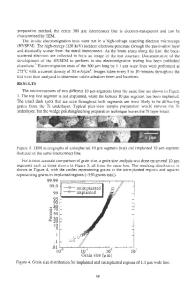Grain Boundary Grooving as the Mechanism of the Blech Electromigration in Interconnects
- PDF / 472,924 Bytes
- 6 Pages / 414.72 x 648 pts Page_size
- 30 Downloads / 367 Views
1.Introduction "Homogeneous", or Blech electromigration (EM) describes macroscopically homogeneous displacement of the up-wind end of thin filhn interconnect lines in microelectronic devices [1-4]. The rate of the process in the tiny-grain polycrystalline films has been considered so far to be controlled by the grain boundary diffusion. The present work for the first time treats homogeneous EM in terms of grain boundary grooving as the underlying mechanism, with the surface diffusion critically involved. It will be shown that kinetics of EM can be described as kinetics of propagationof grain boundary (GB) grooves with EM flux at their roots, while the shape of groove determines the mass of material left behind the driftingend of the line. Microscopically, the process responsible for EM displacement cannot be viewed as homogeneous for at least two reasons. First, in the majority of drift experiments well-detectable part of the stripe material was observed by scanning electron microscopy (SEM) to be left on the substrate behind the trailing end (see, for example, [1,5] for Al, [2] for Au and [6] for Cu lines). Second, in service conditions or in any relevant accelerated testing conditions EM flux in thin films is concentrated mainly along GBs. Clearly, the depletion of matter from GBs must be accommodated by a diffusion flux providing the matter into GBs from adjacent grains. Under low temperature EM- conditions, bulk diffusion is out of question and the main role is played by surface diffusion along the walls of GB grooves. The effect of coupled GB diffusion flux under external potential fields (electric, stress etc.) and capillary driven surface diffusion on GB grooving was analyzed for specific cases in [7-10], and 243 Mat. Res. Soc. Symp. i'roc. Vol. 391
0 1995
Materials Research Society
more recently in [1 ], where a general framework for considering the problem was elaborated. It was shown that because surface diffusion acts in series with GB diffusion, both the shape and the growth rate of GB grooves are determined by the relative mobilities of atoms along GB and along the surface. In the first section of the present work we describe the model that relates EM drift velocity of the up-wind end of the stripe in the Blech test geometry and the residual mass of the film left behind the trailing end to the groove propagation rate and groove width, respectively. In the second section experimental observations of the residual mass dependence on EM drift velocity in Al thin film stripes are given in comparison with the developed elemental theory. The last section deals with the interpretation of different regimes of EM kinetics in terms of grooving rate. 2. Model If surface diffusion provides rapid transport of matter from the surface of the adjacent grains of the diameter, 2d, to the groove tip where the local equilibrium should be maintained, then the GB diffusion acts as the rate controlling step in groove propagation This regime (in the sequel referred to as A-regime of grooving) describes the uniform displace
Data Loading...











